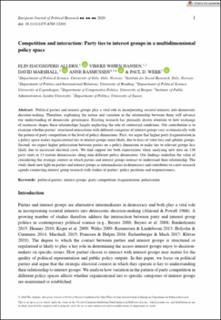Competition and interaction: Party ties to interest groups in a multidimensional policy space
Journal article, Peer reviewed
Published version

Åpne
Permanent lenke
https://hdl.handle.net/11250/2760306Utgivelsesdato
2021Metadata
Vis full innførselSamlinger
Originalversjon
European Journal of Political Research. 2021, 60 (2), 275-294. https://doi.org/10.1111/1475-6765.12403Sammendrag
Political parties and interest groups play a vital role in incorporating societal interests into democratic decision-making. Therefore, explaining the nature and variation in the relationship between them will advance our understanding of democratic governance. Existing research has primarily drawn attention to how exchange of resources shapes these relationships largely neglecting the role of contextual conditions. Our contribution is to examine whether parties’ structured interactions with different categories of interest groups vary systematically with the pattern of party competition at the level of policy dimensions. First, we argue that higher party fragmentation in a policy space makes organisational ties to interest groups more likely, due to fears of voter loss and splinter groups. Second, we expect higher polarisation between parties on a policy dimension to make ties to relevant groups less likely due to increased electoral costs. We find support for both expectations when analysing new data on 116 party units in 13 mature democracies along nine different policy dimensions. Our findings underline the value of considering the strategic context in which parties and interest groups interact to understand their relationship. The study sheds new light on parties and interest groups as intermediaries in democracy and contributes to a new research agenda connecting interest group research with studies of parties’ policy positions and responsiveness.
